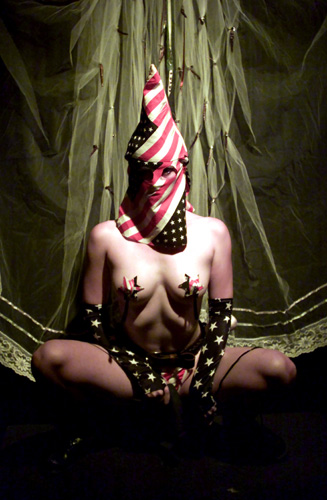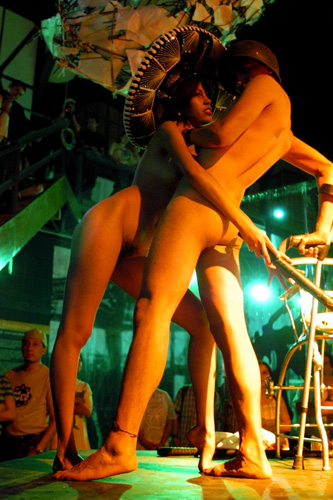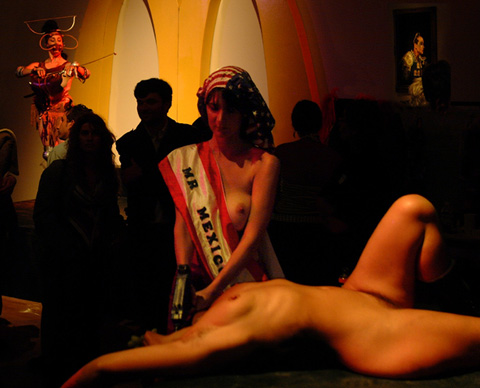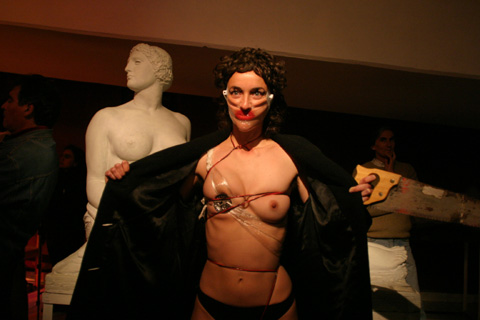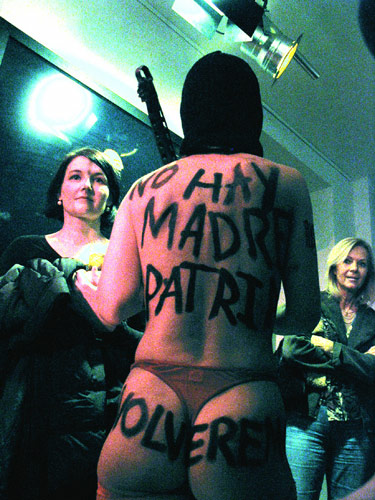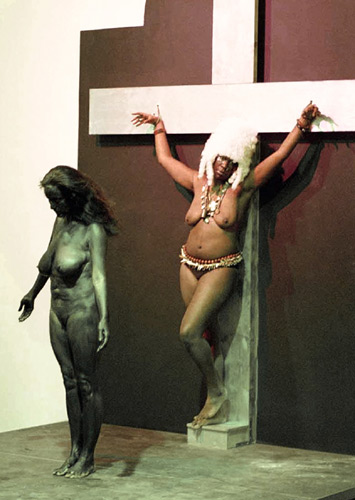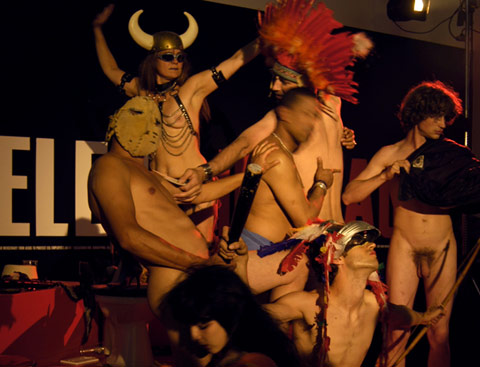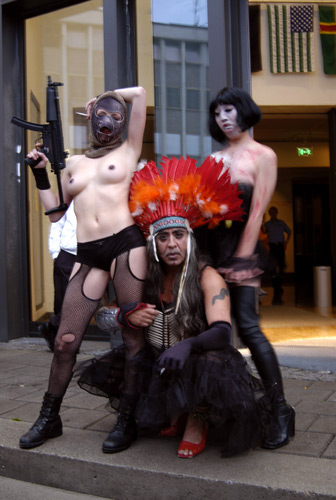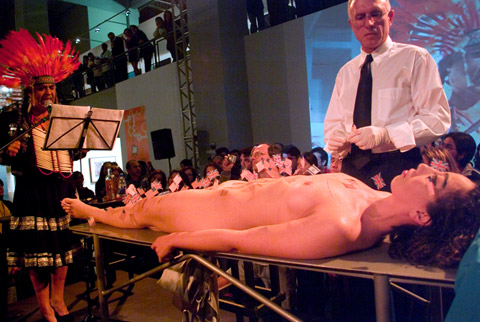In this rarefied atmosphere of
paranoia, distrust, and scrutiny, performance artists have come to signify "potential
trouble" for U.S. art institutions. We always do in times of crisis.
We are perceived as irresponsible provocateurs, gratuitous iconoclasts, and,
since 9/11, as cultural terrorists. Despite the fact that our audiences continue
to be quite large (La Pocha averages 400 spectators every night we perform),
we are invited with provisos, interrogated in advance by curators, and treated
as potential troublemakers by the media. It's...a new American art rite.
The dreaded phone call comes a couple months before the project. The presenter's
voice is audibly anxious. The worst possible scenario goes more or less like
this:
PRESENTER: Gómez-Peña, we just had a board meeting last night
and felt it was better not to bring your troupe to our city at this time.
Maybe next year. The stakes are too high right now. We can't afford to risk
our upcoming funding.
GÓMEZ-PEÑA: Well, thanks for being so...so sincere, Mister...culero... (the
last word uttered under my breath).
next... /
/ back...
Other times, when the cultural institution decides to go ahead with the
project but still has some apprehensions, the conversation occurs, either
by phone or in person, a few days before opening night. If it happens in
person, we are taken to a nice art bar and, after a few drinks—bless
his/her heart—the curator or presenter takes a deep breath and starts
the euphemistic interrogation:
PRESENTER: Guillermo, by no means do we want to censor you. We just want
to know what we are up against in your upcoming piece. You know...we must
be prepared in case...there are fire alarms...
GÓMEZ-PEÑA: (And fire alarms tend to go off when you're
looking for smoke, I think to myself) Can you be more specific,
my friend? (I know where they are going, but I don't know how grave their
fears are.)
PRESENTER: I mean...is this performance "audience-friendly?" (A
euphemism for art without venom or sharp edges.) Is there anything
we should be worried about? Frontal nudity? Violence and sex? (The deadly
combo.) Bloodletting? Exposure to bodily fluids? Will your performers
touch any audience member inappropriately? Will you force any audience member
to do anything that might be considered humiliating or offensive? Any profanity?
Any disrespect for religious imagery? Will there be flag desecration? Will
you be making fun of The Troops? (The list of fears and taboos intertwined
with performance art clichés goes on and on and on-depending on the
site, the project, and the presenter.)
next... /
/ back...
Sometimes the presenter's "concerns" might be addressed with an
emphatic disclaimer placed at the entrance of the gallery or theatre, something
like: "There will be nudity and/or adult content and/or political images
which you may find offensive..." If the museum director or presenter
is a hip Vato, he may let me write my own disclaimer—Gómez-Peña style.
I always try to create a funny disclaimer that heightens the specific fears
of the curator or the institution—something like: "You are about
to witness chicken nudity and unnecessary Mexican violence. Think twice before
you cross this border."
Or, "Patriots should think twice before entering into an internationalized
space." Or, "The artists are not responsible for identity crises
audience members might endure during the performance." It works. But
other times, when the stakes are higher (or the city is more conservative),
the art bar chat with the curator becomes a clear-cut warning—either
we tone down the political/sexual content of the piece, or the project will
be "postponed" (a euphemism for canceled). Short of handing the
presenter a script in advance, we try to be as specific as we can in terms
of describing the images and performance rituals in our piece. We then try
to negotiate, case by case, image by image, the inclusion/exclusion of the
most sensitive material. It's tough. If we give in too much, then the project
becomes defanged, decaffeinated. But if we don't pay attention to their fears
and just go ahead and do whatever we want, we will immediately be blacklisted
in their circuit. It's like performing in 1970s provincial Mexico.
next... /
/ back...
A presenter told me recently, "There are clearly new forbidden territories
which a performance artist must avoid if he wishes to remain employed in
the U.S." The obvious subtext was: Please, make sure that the piece
you are about to present here is not going to get me in trouble. Because
if I get in trouble, so will you.
The main problem is that the fears of the U.S. presenters are well-founded;
their moral dilemmas are real. My heart truly goes out to them. Their institutions,
whether mainstream or "alternative" (does anyone know what "alternative" even
means nowadays?), are rapidly losing their funding. Besides, the local media
is not as willing to defend art as it used to be, and the newly empowered "faith-based
organizations" are constantly looking for blood—potential art
scandals to call down the wrath of God.
In this highly-charged political climate, many arts presenters and curators
believe that their funding, and even their jobs, may be riding on the projects
they present, so a potential media scandal or even a single hysterical complaint
from a righteous audience member might influence the generosity of a donor
or funder; or worse (knock on wood), it might incur the wrath of a
Christian organization or a group of ferocious "patriots." Then
the shit really hits the fan, and both the institution and the artists are
attacked with hate mail and picketed by zombies. We might even be added to
one of the many lists of "cultural traitors" featured on sites
such as www.probush.com/traitor
or www.americantraitor.us.
next... /
/ back...
Despite the undeserved reputation of performance artists as professional
provocateurs and cultural iconoclasts, we really see ourselves on the same
side as our cultural institutions. It is clear to us that we are all part
of the same milieu, and that their fate is connected to ours. Since
our job is by no means to contribute to their de-funding, (and we certainly
don't wish to give more ammunition to the ferocious Right), when the "trial
by fire" occurs, we tend to back off and comply. We do it, not out of
fear, but out of solidarity and political intelligence. Some curators and
presenters know this. But sadly, not all do. This is why, as artists, we
must constantly remind them: "We are on your side, carnales. In
times like these, we need to help each other. We (the artists), need you
guys to broker on our behalf, and defend our integrity. In exchange, we will
make sure that no acts of 'irresponsible transgression' occur on your watch."
Article by Guillermo Gómez-Peña.

